
Still active today, Bob Jackson Cycles are a British builder of classic steel bicycles that is well known around the world. Less commonly known is the name JRJ Cycles that preceded it. Bob (John Robert) Jackson began building bicycle frames in Leeds, England, in 1935, offering track and road racing (time trial) models. Part of Chris Sharp's collection, this particular bike is a 1950s grass track racer that once belonged to Leslie White of the Maryland Wheelers near Belfast. The owner raced it into the late 1960s, achieving numerous victories in Northern Ireland. He then hung it up, and the bike remained untouched for over 4 decades. Today it is preserved in as-raced condition.

The JRJ name, headbadge and transfers were used exclusively until the 1960s, and still appeared into the 1980s after the switch to "Bob Jackson."
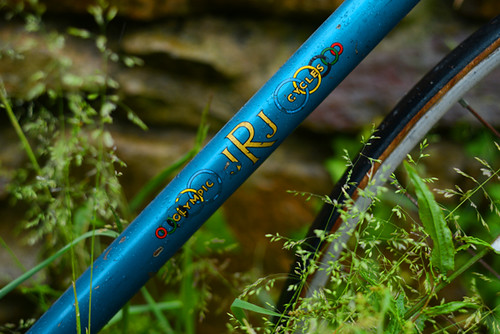
The transfers included renderings of olympic rings, the full name on the downtube reading "JRJ Olympic Cycles." As with other English "lightweight" manufacturers of that time, there was a strong emphasis on performance and competition, which explains the olympic imagery. "Always first at the finish!" was the JRJ Cycles' slogan on advertisements from the 1950s.
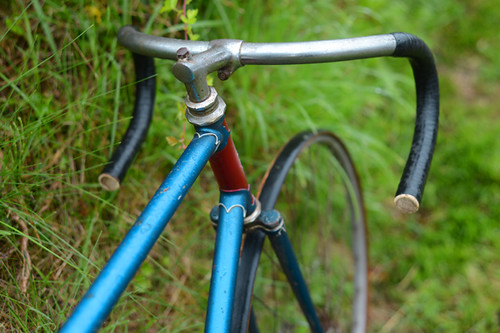
Traditionally, English racing frames from this era tended to be painted in saturated, jewel-like tones, known as a "flamboyant" finish. Not quite the same as pearlescent paint, the flamboyant colours are foil-like, resembling the look of candy wrappers. Bob Jackson had his favourite signature shades, including the red and blue on this bike. The blue leans toward seafoam, and the red is a raspberry-like crimson.
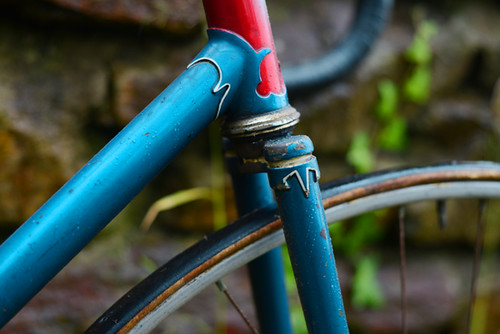
White lining around the lugs and fork crown highlights the elaborate shorelines.

The bottom bracket lugs are especially interesting - there appears to be a reinforced lug of sorts connecting the chainstays to the bottom bracket.
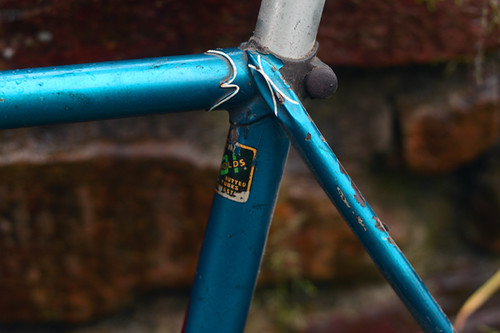
The frame is Reynolds 531 tubing.

Though it has not been ridden in decades, the large shimmery machine is so marked by care and wear, that it feels alive with the owner's presence and energy. Seeing it leaned against the hedge on a rainy morning, I can't help but imagine the tall, powerful youth Leslie White must have been - his back stretched flat across the 58cm frame, his hands gripping the deep track drops, his legs pushing the monstrous gear in an all-out effort around a grass track.
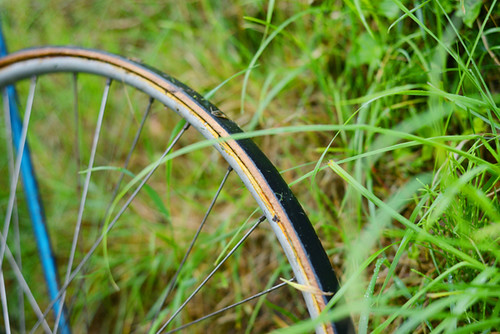
Grass track racing is an interesting tradition in the British Isles. In an earlier post, I mentioned how a ban on road racing from the 1890s through the 1950s led to the invention of time trials. The ban also explains the emphasis on track cycling in the UK and Ireland: Races on enclosed courses were the only kind officially permitted during this time. The grass tracks were similar to velodromes in that they were oval. However, the surface was not banked. Often the track was a multi-use field, temporarily set up for the race.Grass track racing is still done in the UK today, its popularity revived in recent years. At a grass-roots/ community level, a race like this can be organised fairly easily, wherever a flat playing field is available.
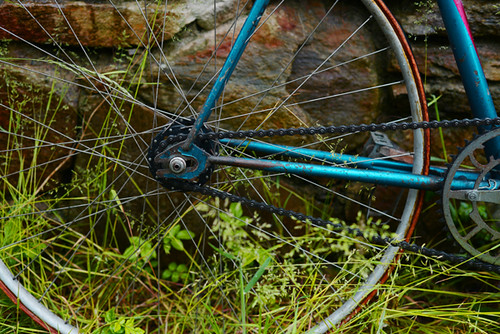
The style of races held was similar to those on the velodrome, and the bikes were fixed gear machines with track style fork-ends.

Typically the fork crown was drilled for a front brake: The rider would remove it upon arrival to the race. The tires were of course tubulars - "sew ups." Too deteriorated to hold air, the ones on this bike are original.
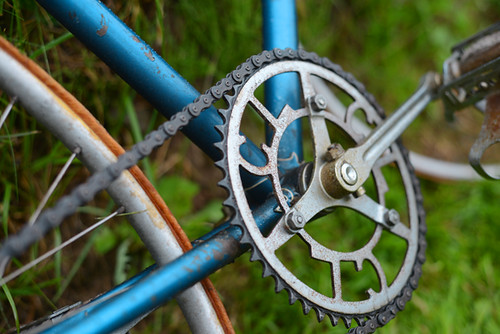
Also original are all the other components. Most notable among these are the English-made Chater Lea crankset and hubs, quite rare now.
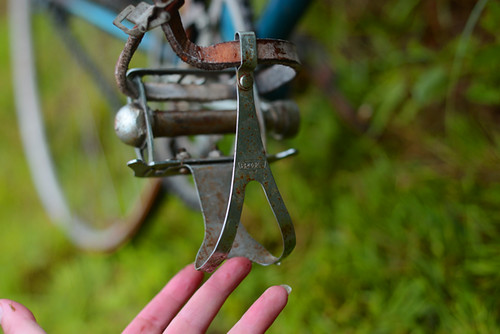
The Chater Lea pedals are fitted with Brooks toe clips and leather straps.
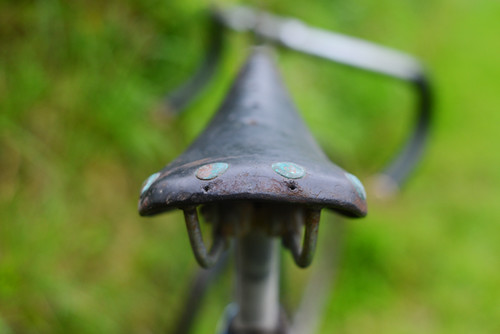
I can make out a faint Brooks stamp on the side of the saddle, but not which model it is. The saddle is long and very narrow - measuring just over 120mm across at the widest part.
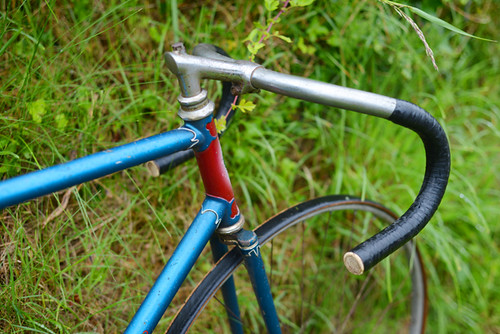
The stem and handlebars are stamped with what looks like Cinelli; I did not want to disturb the patina by cleaning up the inscription.
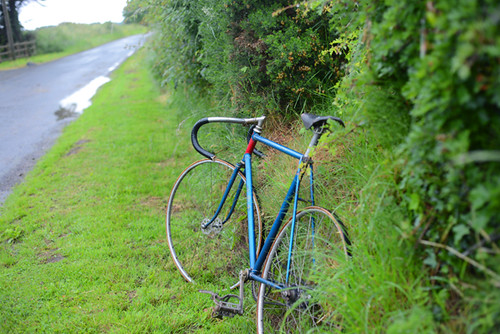
When talking to Chris Sharp about the JRJ, I asked whether he plans to make it ridable. He has many vintage bikes, some of them quite old and storied, and he does not shy away from using them. But Leslie White's grass racer, he wants to preserve the way it is. Having met the bike's original owner, part of it is wanting to honor him. But part of it also is the history. In person, standing near this bike and touching it... There is just something so incredibly alive and exciting about how freshly used everything looks.I can readily imagine it all: a grassy field, a gray sky, a crowd of locals gathered to watch, and the riders - a blur of jewel tones against the overcast country landscape.
 We stopped by Harris Cyclery today to pick up some components and I swear I had absolutely no intention to test-ride a Brompton. I mean, the Bromptons have been occupying a large corner of the shop since the first time we visited Harris - and I have always resisted them. But today? Well, today was a very hot day. And this lemon-yellow Brompton just looked so darn refreshing. So I will blame it on heatstroke.
We stopped by Harris Cyclery today to pick up some components and I swear I had absolutely no intention to test-ride a Brompton. I mean, the Bromptons have been occupying a large corner of the shop since the first time we visited Harris - and I have always resisted them. But today? Well, today was a very hot day. And this lemon-yellow Brompton just looked so darn refreshing. So I will blame it on heatstroke.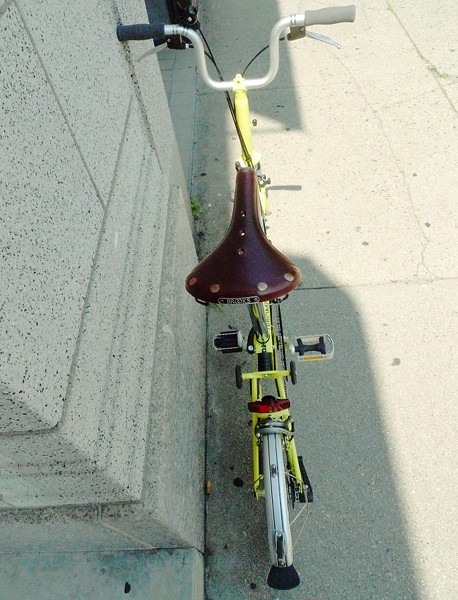 Here is an "aerial" view. This is the 2-speed model with upright handlebars and Brooks saddle. The bikes come in many versions, and options include dynamo lighting, titanium parts, mountain or trekking handlebars, and about a dozen colour choices.
Here is an "aerial" view. This is the 2-speed model with upright handlebars and Brooks saddle. The bikes come in many versions, and options include dynamo lighting, titanium parts, mountain or trekking handlebars, and about a dozen colour choices.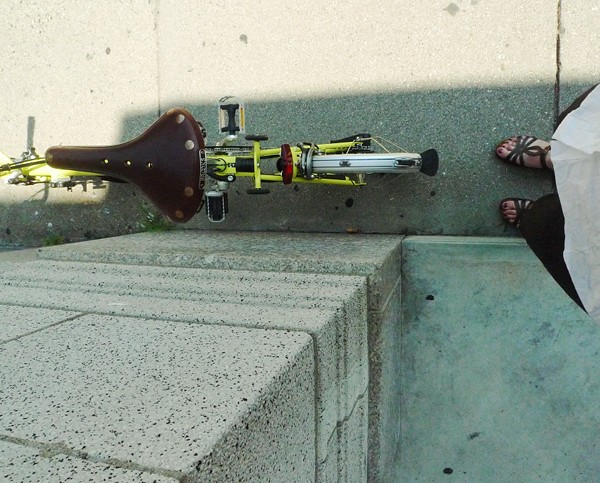 To be honest, I was initially apprehensive about trying this bike- having heard from some women that it feels "twitchy" to ride and difficult to control. But his charming demeanor won me over, and I gave it a try - first adjusting the saddle to a comfortable height, which was fairly easy with the quick release lever.
To be honest, I was initially apprehensive about trying this bike- having heard from some women that it feels "twitchy" to ride and difficult to control. But his charming demeanor won me over, and I gave it a try - first adjusting the saddle to a comfortable height, which was fairly easy with the quick release lever.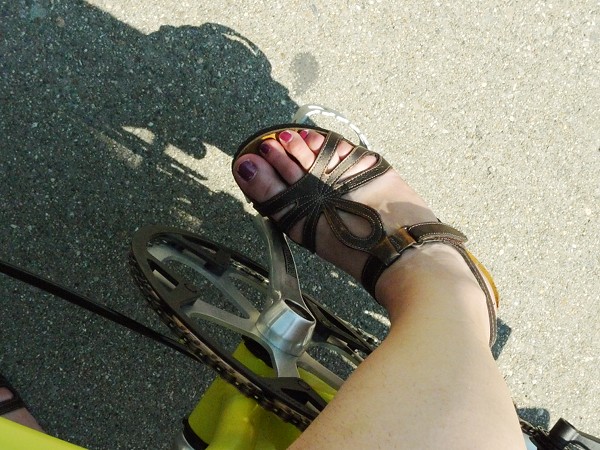 There was no one around to take a picture of my test ride, so you will have to take my word for it. To me, the bike did not really feel difficult to control in the course of the short ride. The braking power was excellent, the steering responsive but not twitchy, the pedals wide and grippy. The handlebars just the right height and I was in a position that was pretty much upright. And of course, the Brompton was easy to mount and dismount.
There was no one around to take a picture of my test ride, so you will have to take my word for it. To me, the bike did not really feel difficult to control in the course of the short ride. The braking power was excellent, the steering responsive but not twitchy, the pedals wide and grippy. The handlebars just the right height and I was in a position that was pretty much upright. And of course, the Brompton was easy to mount and dismount.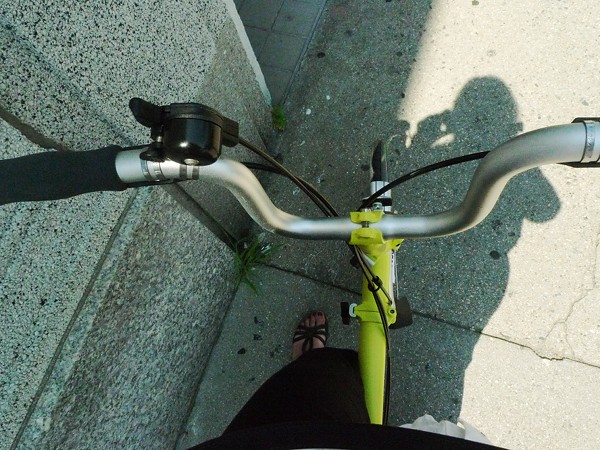 My one and only problem was with the angles of the handlebar grips. They put my hands into the "mountain bike bar" position, with my fists straight in front of me - a no-no for the damaged nerves in my hands. I hear that it is possible to attach extensions to the grips that would place my hands into the "North-roads" position, and so that is what I would do if I were to actually get a Brompton. Have any of the Brompton owners out there done this?
My one and only problem was with the angles of the handlebar grips. They put my hands into the "mountain bike bar" position, with my fists straight in front of me - a no-no for the damaged nerves in my hands. I hear that it is possible to attach extensions to the grips that would place my hands into the "North-roads" position, and so that is what I would do if I were to actually get a Brompton. Have any of the Brompton owners out there done this? As for the looks and construction of the bikes, I think the cuteness and technical ingenuity of the Brompton is fairly well known at this point, so I will not bother repeating it all. But what you don't always notice in the industry reviews are the charming details - like this handsome lugged flat-top fork crown.
As for the looks and construction of the bikes, I think the cuteness and technical ingenuity of the Brompton is fairly well known at this point, so I will not bother repeating it all. But what you don't always notice in the industry reviews are the charming details - like this handsome lugged flat-top fork crown.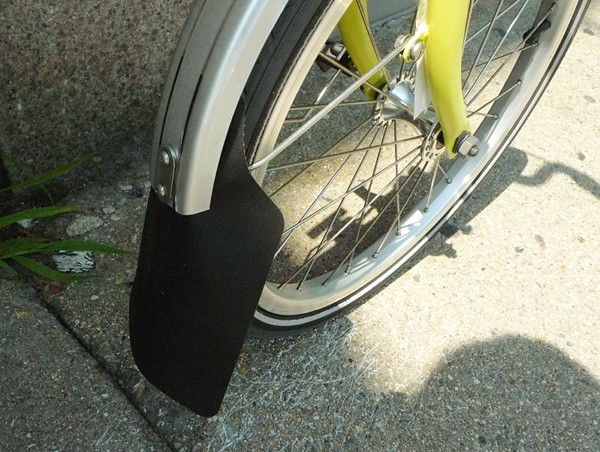 ...and this miniature mud flap!
...and this miniature mud flap! Another interesting detail about the Bromptons, is that they use a lot of proprietary components - the Brompton name is stamped on the brakes, pedals, and other parts.
Another interesting detail about the Bromptons, is that they use a lot of proprietary components - the Brompton name is stamped on the brakes, pedals, and other parts. But the most striking thing of all, is the attitude of the Harris Cyclery staff towards Bromptons. They are crazy about them, and it seems that most of them have one. Jon Harris (pictured above) and his wife both ride them. It is clear that the shop stands behind this manufacturer 100%.
But the most striking thing of all, is the attitude of the Harris Cyclery staff towards Bromptons. They are crazy about them, and it seems that most of them have one. Jon Harris (pictured above) and his wife both ride them. It is clear that the shop stands behind this manufacturer 100%.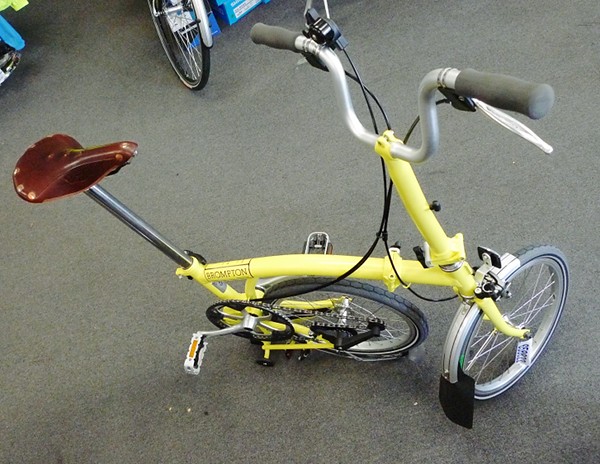 I realise that I keep neglecting the folding aspects of the bike and all the technical specs - but come on, we all know that it folds, and it is supposed to be the best folding bike out there. What I wanted to focus on more, was my personal impression - especially as I have noticed that women seem to be intimidated by these bikes and tend to choose Dahon and Bike Friday folding bikes instead. Personally, I have tried both Dahon, Bike Friday, and a few other folders, and none of them have ever "spoken" to me. Despite the fact that I travel a lot and could really use a folding bike, I've just never been attracted to folders and have never wanted one. Having finally tried the Brompton, I am having second thoughts.
I realise that I keep neglecting the folding aspects of the bike and all the technical specs - but come on, we all know that it folds, and it is supposed to be the best folding bike out there. What I wanted to focus on more, was my personal impression - especially as I have noticed that women seem to be intimidated by these bikes and tend to choose Dahon and Bike Friday folding bikes instead. Personally, I have tried both Dahon, Bike Friday, and a few other folders, and none of them have ever "spoken" to me. Despite the fact that I travel a lot and could really use a folding bike, I've just never been attracted to folders and have never wanted one. Having finally tried the Brompton, I am having second thoughts.
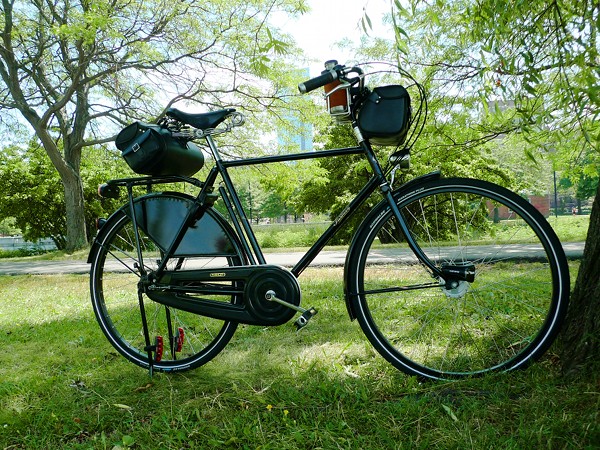 For a while now, the Co-Habitant has been wanting water bottle cages on his Pashley Roadster. I thought the idea was ridiculous, until I received a few comments from male Pashley owners expressing the same desire. I guess men like bottle cages on their bikes, even on a roadster? Fair enough! For those interested, here is the Co-Habitant's DIY solution:
For a while now, the Co-Habitant has been wanting water bottle cages on his Pashley Roadster. I thought the idea was ridiculous, until I received a few comments from male Pashley owners expressing the same desire. I guess men like bottle cages on their bikes, even on a roadster? Fair enough! For those interested, here is the Co-Habitant's DIY solution: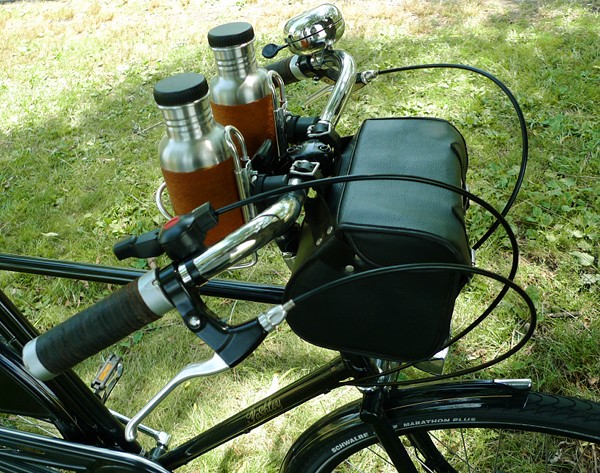 Yes, you are seeing what you think you are seeing: Not one, but two bottle cages mounted on the inside of the handlebars, with twined, flat-cappedKleen Kanteen bottles inside them. The bottle cages are generic bolt-ons that can be found in many bike shops for around $7 (same bottle cages as here). For the Pashley, the Co-Habitant first took them apart, shortened them so that they would not stick out too far past the handlebars (I believe the drill and superglue were used), and bolted them to the handlebars, with the bottles facing inward. Now he has direct access to water, while remaining upright.
Yes, you are seeing what you think you are seeing: Not one, but two bottle cages mounted on the inside of the handlebars, with twined, flat-cappedKleen Kanteen bottles inside them. The bottle cages are generic bolt-ons that can be found in many bike shops for around $7 (same bottle cages as here). For the Pashley, the Co-Habitant first took them apart, shortened them so that they would not stick out too far past the handlebars (I believe the drill and superglue were used), and bolted them to the handlebars, with the bottles facing inward. Now he has direct access to water, while remaining upright. Here is the "cockpit view". And yes, that is a cycling computer you see mounted on the stem, in between the bottle cages. On a Pashley. What can I say, the man has his quirks.
Here is the "cockpit view". And yes, that is a cycling computer you see mounted on the stem, in between the bottle cages. On a Pashley. What can I say, the man has his quirks. My opinion on this project? I think that if he mounted just one bottle and stopped there, it would have been successful.
My opinion on this project? I think that if he mounted just one bottle and stopped there, it would have been successful. With two bottles, I think he went overboard with the eccentricity factor and the bottles look like a pair of missiles. What do you think?
With two bottles, I think he went overboard with the eccentricity factor and the bottles look like a pair of missiles. What do you think?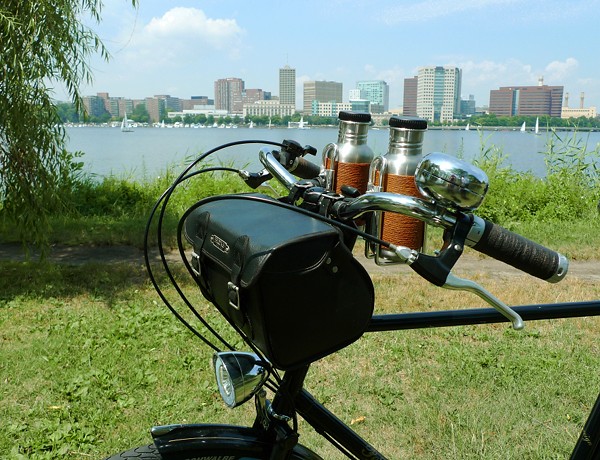 And if you are wondering why he did not just use one of those coffee-cup mounts that are designed for the handlebars, he did not think they were sturdy enough, or accommodating enough of different containers. I agree: These bottle cages are super-stable and the bottles do not budge or vibrate at all inside them. It is a very secure set-up, and the flasks can be filled with coffee as well as water.
And if you are wondering why he did not just use one of those coffee-cup mounts that are designed for the handlebars, he did not think they were sturdy enough, or accommodating enough of different containers. I agree: These bottle cages are super-stable and the bottles do not budge or vibrate at all inside them. It is a very secure set-up, and the flasks can be filled with coffee as well as water. While I do not agree with the choice to mount two bottles, I think that otherwise this is an innovative and practical solution. I am now considering installing a similar set-up (with just one bottle though!) on myPashley Princess.
While I do not agree with the choice to mount two bottles, I think that otherwise this is an innovative and practical solution. I am now considering installing a similar set-up (with just one bottle though!) on myPashley Princess.






























 This prairie dog figurine came from Prairie Dog Town some where on the road between Pampa, TX and Amarillo, TX. In about 1955 my mom, my grandmother, and I made the trip from Pampa to Amarillo about once a month or more often when I mom was pregnant with my sister. We were living in Pampa and the Air Force base where my mom had to go for her appointments was near Amarillo. My dad was stationed in England at that time. The Prairie Dog Town made a nice stop for all of us. There was a cafe, gift shop, and a fenced area out back that was full of prairie dogs for the guest to watch as they went about their prairie dog lives. They were feed by the people that ran the place and were a great attraction especially to me. For those that don't know a prairie dog is not a dog, they are a rodent (rat) but are cute. They dig long tunnels through an area that becomes the dog town. When one of them is startled it will stand on it's hind legs give a sharp squeak and dive down the hole with all the others then doing the same thing. They are also very dangerous to livestock and people who have stepped in their holes and broken legs. At one time there was a bounty on them over most of the southwest. We have a few out here on the desert near where we live. They are so leery of humans I have never seen one but have found the towns with the many holes leading to the tunnels.
This prairie dog figurine came from Prairie Dog Town some where on the road between Pampa, TX and Amarillo, TX. In about 1955 my mom, my grandmother, and I made the trip from Pampa to Amarillo about once a month or more often when I mom was pregnant with my sister. We were living in Pampa and the Air Force base where my mom had to go for her appointments was near Amarillo. My dad was stationed in England at that time. The Prairie Dog Town made a nice stop for all of us. There was a cafe, gift shop, and a fenced area out back that was full of prairie dogs for the guest to watch as they went about their prairie dog lives. They were feed by the people that ran the place and were a great attraction especially to me. For those that don't know a prairie dog is not a dog, they are a rodent (rat) but are cute. They dig long tunnels through an area that becomes the dog town. When one of them is startled it will stand on it's hind legs give a sharp squeak and dive down the hole with all the others then doing the same thing. They are also very dangerous to livestock and people who have stepped in their holes and broken legs. At one time there was a bounty on them over most of the southwest. We have a few out here on the desert near where we live. They are so leery of humans I have never seen one but have found the towns with the many holes leading to the tunnels.



